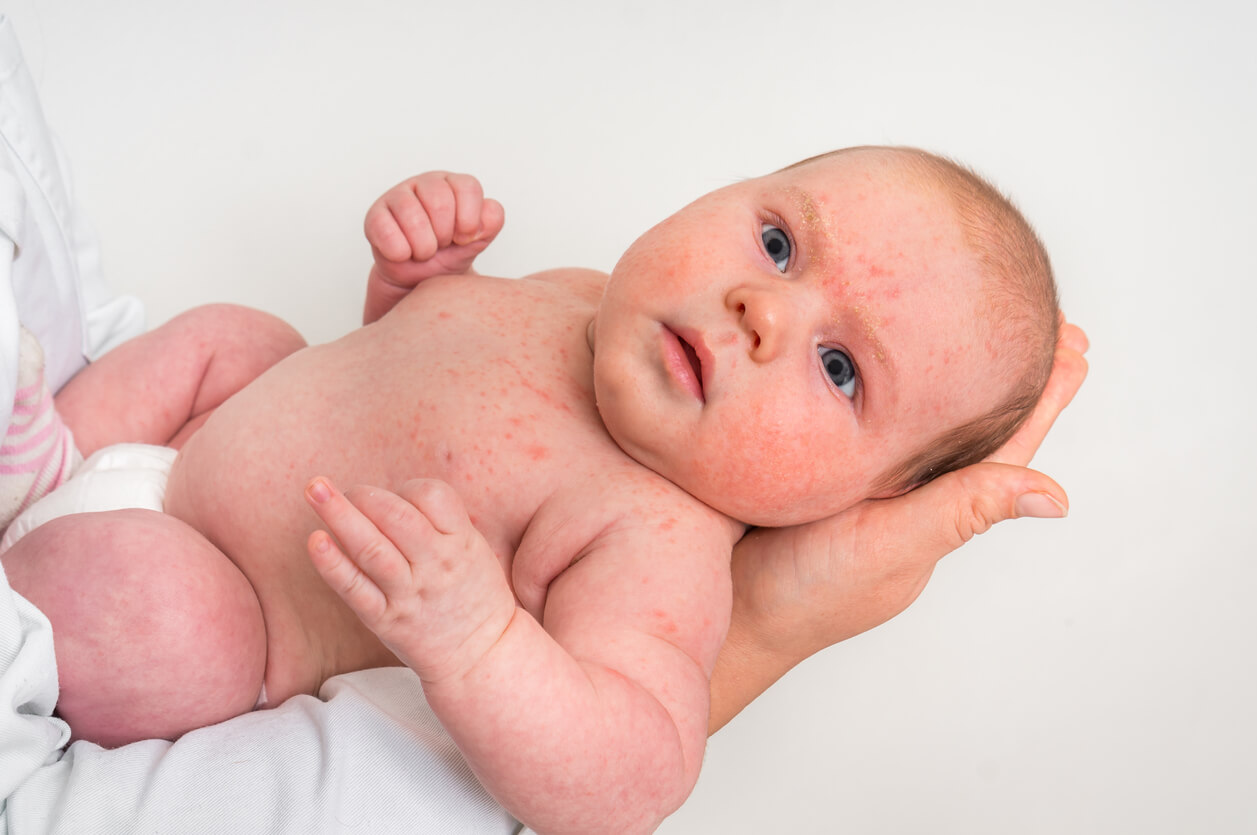Petechiae in Infants: Symptoms, Causes, and Treatment


Written and verified by the dermatologist Maria del Carmen Hernandez
Petechiae in infants are a common manifestation and can be a major cause for concern for parents because of their sudden onset. However, most cases have a benign cause or tend to be drug-induced with a good prognosis when the drug in question is discontinued.
What are petechiae in infants?
Petechiae are red spots that are less than 2 mm in size and affect the skin and mucous membranes. Therefore, they’re the result of the presence of areas of hemorrhage in the dermis layer. These usually appear in clusters and are red and round like the head of a pin. They don’t fade or disappear when pressed and can appear anywhere on the body.
Those measuring more than 2 mm are called purpura, but don’t differ in their morphological characteristics from petechiae. Both are even flat to the touch, so they’re not raised.
You may be interested in: What Are Those Little Red Spots on My Baby’s Skin?
Causes of petechiae in infants

There are many causes of petechiae in infants that should be considered. In addition, the American Academy of Pediatrics classifies them according to their origin in different categories:
- Traumatic: Accidental or non-accidental injuries and increased pressure after attacks of vomiting, coughing, or exertion.
- Infectious causes: May be viral (parvovirus B19, enterovirus, dengue), bacterial (scarlet fever, meningococcal, infective endocarditis), rickettsial (Rocky Mountain spotted fever), and congenital.
- Malignancy and hematologic: Idiopathic thrombocytopenic purpura (ITP), leukemia, splenomegaly, hemolytic uremic syndrome (HUS), disseminated intravascular coagulation (DIC), Fanconi’s anemia, and neonatal alloimmune thrombocytopenia.
- Inflammatory conditions and vasculitis: Henoch-Schonlein purpura and systemic lupus erythematosus.
- Connective tissue disorder: Ehlers-Danlos syndrome.
- Congenital origin: Wiscott-Aldrich syndrome, Glanzmann thrombasthenia, or Bernard-Soulier syndrome.
- Others: Drug reactions (penicillin, phenytoin, quinine, sodium valproate), chronic liver disease, or vitamin K deficiency.
The age of the child can be of great help in arriving at a more accurate diagnosis. For example, a newborn with petechiae could have a TORCH infection (toxoplasma, treponema, rubella, cytomegalovirus, and herpes simplex) or NAIT (neonatal alloimmune thrombocytopenia), while HSP (Henoch-Schonlein purpura) is more common between the ages of 2 and 5 years.
Clinical manifestations of petechiae in infants
A thorough history and physical examination are essential for all infants and children who have petechiae. In addition, features to be aware of include any other associated symptoms, timing of onset, and anatomic pattern.
The most concerning patterns of signs and symptoms that appear along with petechiae involve the following:
- EMI: Tachycardia, febrile state, and rapidly spreading petechiae.
- Malignancy: Bruising, pallor, weight loss, or lymphadenopathy.
- Renal disease associated with HUS, HSP, or SLE: Hypertension.
- NAI: Inconsistent story or signs of injury or neglect, unusual patterns of petechiae with bruising.
Those petechiae limited to the area above the nipple line are linked to episodes of coughing or vomiting. However, they can appear on the face, chest, abdomen, arms, buttocks, and feet. In addition, they don’t cause itching and even tend to be confused with dermatitis or allergies.
Read also: Children with Skin Allergies: Symptoms and Recommendations

Treatment options for petechiae in infants
A little one with fever and petechiae requires a thorough evaluation on an urgent basis. However, skin spots aren’t always accompanied by other associated symptoms. While there are many causes of a petechial rash in infants, invasive meningococcal disease (IMD) caused by Neisseria meningitidis is one of the most worrisome causes.
Petechiae in infants and pediatric care
Any appearance of petechiae on the skin requires attention by trained and qualified personnel because it may be a manifestation of a more complex condition. It goes without saying that in case of episodes of lethargy, high fever, abnormal pulse, or increased progression and evolution of petechiae, urgent medical attention should be sought.
Petechiae in infants are a common manifestation and can be a major cause for concern for parents because of their sudden onset. However, most cases have a benign cause or tend to be drug-induced with a good prognosis when the drug in question is discontinued.
What are petechiae in infants?
Petechiae are red spots that are less than 2 mm in size and affect the skin and mucous membranes. Therefore, they’re the result of the presence of areas of hemorrhage in the dermis layer. These usually appear in clusters and are red and round like the head of a pin. They don’t fade or disappear when pressed and can appear anywhere on the body.
Those measuring more than 2 mm are called purpura, but don’t differ in their morphological characteristics from petechiae. Both are even flat to the touch, so they’re not raised.
You may be interested in: What Are Those Little Red Spots on My Baby’s Skin?
Causes of petechiae in infants

There are many causes of petechiae in infants that should be considered. In addition, the American Academy of Pediatrics classifies them according to their origin in different categories:
- Traumatic: Accidental or non-accidental injuries and increased pressure after attacks of vomiting, coughing, or exertion.
- Infectious causes: May be viral (parvovirus B19, enterovirus, dengue), bacterial (scarlet fever, meningococcal, infective endocarditis), rickettsial (Rocky Mountain spotted fever), and congenital.
- Malignancy and hematologic: Idiopathic thrombocytopenic purpura (ITP), leukemia, splenomegaly, hemolytic uremic syndrome (HUS), disseminated intravascular coagulation (DIC), Fanconi’s anemia, and neonatal alloimmune thrombocytopenia.
- Inflammatory conditions and vasculitis: Henoch-Schonlein purpura and systemic lupus erythematosus.
- Connective tissue disorder: Ehlers-Danlos syndrome.
- Congenital origin: Wiscott-Aldrich syndrome, Glanzmann thrombasthenia, or Bernard-Soulier syndrome.
- Others: Drug reactions (penicillin, phenytoin, quinine, sodium valproate), chronic liver disease, or vitamin K deficiency.
The age of the child can be of great help in arriving at a more accurate diagnosis. For example, a newborn with petechiae could have a TORCH infection (toxoplasma, treponema, rubella, cytomegalovirus, and herpes simplex) or NAIT (neonatal alloimmune thrombocytopenia), while HSP (Henoch-Schonlein purpura) is more common between the ages of 2 and 5 years.
Clinical manifestations of petechiae in infants
A thorough history and physical examination are essential for all infants and children who have petechiae. In addition, features to be aware of include any other associated symptoms, timing of onset, and anatomic pattern.
The most concerning patterns of signs and symptoms that appear along with petechiae involve the following:
- EMI: Tachycardia, febrile state, and rapidly spreading petechiae.
- Malignancy: Bruising, pallor, weight loss, or lymphadenopathy.
- Renal disease associated with HUS, HSP, or SLE: Hypertension.
- NAI: Inconsistent story or signs of injury or neglect, unusual patterns of petechiae with bruising.
Those petechiae limited to the area above the nipple line are linked to episodes of coughing or vomiting. However, they can appear on the face, chest, abdomen, arms, buttocks, and feet. In addition, they don’t cause itching and even tend to be confused with dermatitis or allergies.
Read also: Children with Skin Allergies: Symptoms and Recommendations

Treatment options for petechiae in infants
A little one with fever and petechiae requires a thorough evaluation on an urgent basis. However, skin spots aren’t always accompanied by other associated symptoms. While there are many causes of a petechial rash in infants, invasive meningococcal disease (IMD) caused by Neisseria meningitidis is one of the most worrisome causes.
Petechiae in infants and pediatric care
Any appearance of petechiae on the skin requires attention by trained and qualified personnel because it may be a manifestation of a more complex condition. It goes without saying that in case of episodes of lethargy, high fever, abnormal pulse, or increased progression and evolution of petechiae, urgent medical attention should be sought.
All cited sources were thoroughly reviewed by our team to ensure their quality, reliability, currency, and validity. The bibliography of this article was considered reliable and of academic or scientific accuracy.
- Temple R, Bull K. Petechiae in a Newborn. Am Fam Physician. 2015 Dec 1;92(11):1017-8. PMID: 26760417.
- Eriksen BH, Husebekk A, Fugelseth D, Salberg KR, Lindemann R. A newborn with petechiae. Tidsskr Nor Laegeforen. 2013 Apr 9;133(7):761-4. English, Norwegian. doi: 10.4045/tidsskr.12.1009. PMID: 23588181.
- Lee MH, Barnett PL. Petechiae/purpura in well-appearing infants. Pediatr Emerg Care. 2012 Jun;28(6):503-5. doi: 10.1097/PEC.0b013e3182586f5f. PMID: 22653463.
This text is provided for informational purposes only and does not replace consultation with a professional. If in doubt, consult your specialist.








